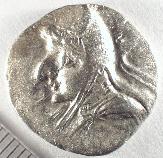
|
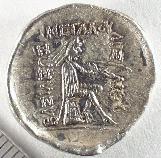
|
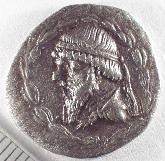
|

|

|
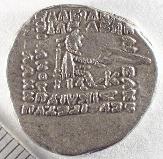
|
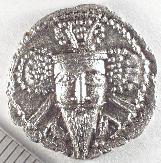
|
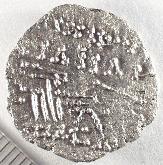
|
archive also available
| Chicago Coin Club | |
|---|---|
| Volume 50 No. 3 | March 2004 |
For the last few years, the club has been fortunate in being able to meet in a beautiful room with excellent visual equipment, all at no charge. Unfortunately, the bank will need all of its meeting rooms for some in-house training programs, for at least the first half of 2004.
The club is looking for another downtown meeting place, but our space, budget, and late meeting time limit our options. Harlan Berk has offered us his upstairs space again for our March 1 meeting; use the building entrance at 77 West Washington, and go to Suite 1320.
Presented by Mark Wieclaw to our February 11, 2004 meeting.
The ancient Kingdom of Parthia covered lands of what is today western Turkey, much of Syria, and all of Iraq and Iran. The Parthian Kings issued coinage from the 2nd century B.C. through the 3rd century A.D. Alexander the Great conquered this area from the Persian Empire, but his empire fractured after his death, with this area becoming the Seleucid Empire.
The Parthians initially kept the Seleucid style of coinage when their empire was established. Although the basic design tried to remain the same, Mark showed how the style slowly changed over time; as the Greek influence faded from everyday life, so did the Greek reverse legends slowly turn into gibberish. The reverse's central design element is an archer, but over time it also became less recognizable.
Although the designs changed, the drachms continued to be made of good silver; this is in contrast to the Roman experience. (Parthians made tetradrachms in only a few areas; their fineness fell at around the middle of the Parthian era, but their fineness somewhat improved later.) Mark showed a number of coins to illustrate the changing designs; here are just a few of them:

|

|

|

|

|

|

|

|
Presented by Allen Mincho to our February 28, 2004 meeting.
Allen Mincho started collecting in 1968 in his native New York, eventually forming a bank note collection comprising notes from over 130 of the 162 issuing banks within the city's five boroughs. On the commercial side, in 1990 he was one of the founders of Currency Auctions of America which recently became a part of Heritage in Texas.
Forming a complete collection of National Bank Notes can become a daunting task once the collector moves past type collecting and moves into collecting by either town or even individual bank; nationally, more than 10,000 banks issued bank notes. Many banks issued notes in more than one denomination, and in more than one type. Combine those with different signatures, and a collector is specialized right out of collecting nationally.
Allen mentioned some of the history of Illinois National Bank Notes, but mostly described how they have been collected. The numismatic market has experienced a number of highs and lows since the first effort at collecting bank notes by town and bank in the 1930s, but although Illinois never was considered one of the hot states to collect, it always did have a number of collectors especially starting in the 1970s and Allen shared his reminiscences with our audience.
Collectors of bank notes by town or even banks usually start out small, with a local focus. Allen described how, in the 1950s, a collector from downstate Pekin started collecting only Tazewell county banks. He was still at it by the 1970s, collecting by towns, signatures, and more; but when faced with looming completion, he expanded his collecting interest first to a three-county area, then to five- and twelve-county areas before collecting the complete state. His collection expanded by purchases made from other collections coming to market, and then his complete collection disappeared from the scene after his death. Less than two years ago, an heir of that collector told Allen that he had a collection that had been appraised at X dollars in 1993 and he wondered if it would still be worth it - it recently sold for much more.
The price increases for Illinois Nationals usually are in spurts, not gradual and steady. Allen told us that he had thought that a pair of dealers had way overpaid for an Illinois collection and would never move the material; but the dealers had been developing a group of new collectors and all of the material ended up selling within a year for strong prices.
But enough about high prices! Allen told how Col. Green and his agent George Blake wanted serial #1 sheets of small size notes then just issued. They sent letters to banks offering to pay some percent over face for each #1 sheet; during the Depression, many bankers took them up on their offer. They had many hundred sheets by Green's death, but his estate had difficulty finding buyers. B. Max Mehl ended up with the sheets and a local collector bought the Texas sheets, explaining why Texas banks now have more available than other states. Some of the remaining sheets were sent to the Federal Reserve Bank in Dallas for face value, and some went to New York. Those last notes ended up in an early 1970s Merkins auction, and that is considered one of the first signs of the recent boom in National Bank Note interest.
One approach to collecting a state's bank notes is an alphabet set, which consists of one note from a town starting with each letter of the alphabet. The only two states for which that is possible are Illinois and Ohio.
In the 1950s, Louis van Belkum started performing searches in national archives to determine what had been authorized and issued. He was not a rich man, so to raise funding he would organize the information by state, and sell it to a collector (or group of collectors) interested in that state. Talk about the nirvana of insider trading! Although the notes from small towns usually are the rarest, one collector had the idea that the notes from the large cities were under-rated and that led to a strong Chicago collection.
The last decade has provided collectors with much more information, much of it in the public domain. Few mysteries remain, and a population census was brought up to date within the last year. Every state has been blessed with at least one major collector, usually resulting in a reference for that state's notes.
The competition between some early collectors was very fierce; calling it heated would be understatement; it was not unheard of for one collector to buy a duplicate just to keep it away from another collector. Things are not that nasty now, but after someone in the audience brought it up, Allen, using no names, described an incident at an Indiana coin show where a good Illinois note had just turned up. One collector was known as tight with a dollar - the quintessentail cheap buyer; whenever he was told the price of anything, he would sound hurt and aggrieved, and would offer less. When he did that to the dealer with the good note, the dealer said, "You should never own this note," took out a match, and burned the note in front of the collector. Supposedly, that collector has changed his perspective.
In response to other questions, there is no "Holy Grail" in the Illinois area, and the Coles Bankers Directory gives addresses and officers of banks; also, business directories are a source of information on banks.
Some images have a scale in the lower-left corner, with the tics spaced 1 mm apart. Because the brightness and contrast were manipulated on a computer, the coloring of a coin's image differs from the coin's actual coloring.

|

|
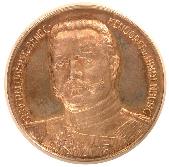
|
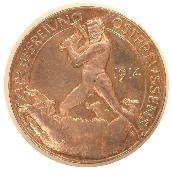
|
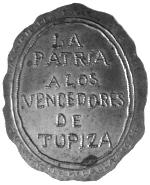
|
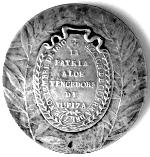
|
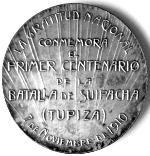
|

|
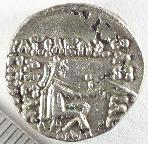
|
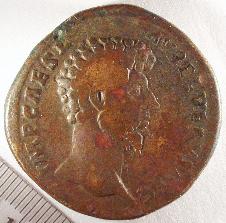
|
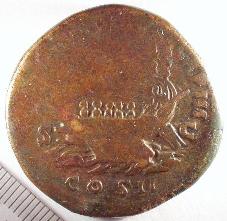
|
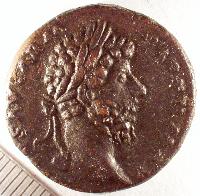
|
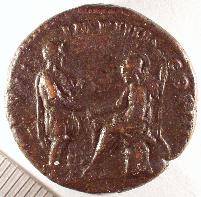
|
| Date: | March 10, 2004 |
| Time: | 7:00 PM |
| Location: | Downtown Chicago
In a meeting room provided by Harlan Berk; at 77 W. Washington St., Suite 1320. |
| Featured speaker: | John Connolly - $1.00 U.S. Coins from Eisenhower to Sacagawea |
|
According to John Connolly, collectors should take another look at the Eisenhower, Susan B. Anthony and Sacagawea dollar coins. These series of coins are still available at reasonable prices in quality condition, but there are a number of varieties that are becoming depleted in dealers' stock. Join us at the March meeting as Mr. Connolly covers some of the specific dates, types and varieties that are becoming hard to find. |
| March | 10 | CCC Meeting - Featured Speaker - John Connolly on $1.00 U.S. Coins from Eisenhower to Sacagawea |
| April | 14 | CCC Meeting - Featured Speaker - Andy Plioplys on The Early Coinage of Lithuania, 1100 - 1400 AD |
| April 30- May 2 |
29th Annual Chicago International Coin Fair (CICF) at the Holiday Inn O'Hare, 5440 North River Road, Rosemont. Admission is $5. | |
| Our May meeting will consist of two sessions: we will end the first session with a recess (instead of an adjournment), and we will reconvene for the second session at our regular monthly time. | ||
| May | 1 | CCC Meeting - 1pm at the Chicago International Coin Fair (CICF),
which is held at the Holiday Inn O'Hare, 5440 North River Road, Rosemont, IL.
No admission charge for our meeting.
Featured Speaker - Richard Giedroyc on Numismatic Issues from the House of Dracula and House of Frankenstein |
| May | 1 | 85th Annivesary Banquet Meeting - 6pm reception, 7pm dinner -
at the Holiday Inn O'Hare, 5440 North River Road, Rosemont, IL.
Reservations required, at $39 per person, for the buffet style dinner. Featured Speaker - to be announced |
| May | 12 | CCC Meeting - Featured Speaker - to be announced |
| April | 1 | Charles J. Ryant, Jr. | |
| April | 12 | Mark Wieclaw | 1991 |
| April | 15 | Robert D. Leonard, Jr. | 1983 |
| April | 15 | Charles Menard | 1995 |
| April | 27 | Don Valenziano | 1982 |
All correspondence pertaining to Club matters
should be addressed to the Secretary and mailed to:
CHICAGO COIN CLUB
P.O. Box 2301
CHICAGO, IL 60690
http://www.ChicagoCoinClub.org/
| Paul R. Hybert |
| prhybert@worldnet.att.net |
| Mark Wieclaw | - President |
| Robert Feiler | - First Vice President |
| Jeff Rosinia | - Second Vice President |
| Directors: | Lyle Daly
Mike Metras Steve Zitowsky Carl Wolf |
| Other positions held are: | |
| Robert Weinstein | - Secretary |
| Steve Zitowsky | - Treasurer |
| Paul Hybert | - Chatter Editor |
| Phil Carrigan | - Archivist |